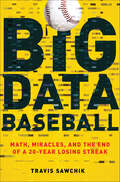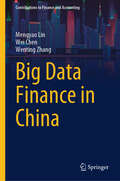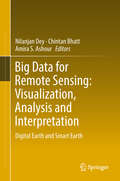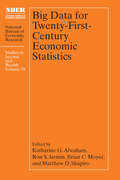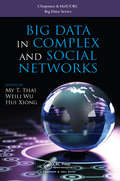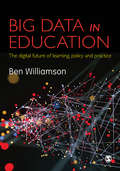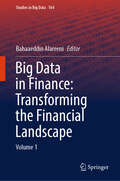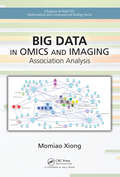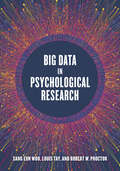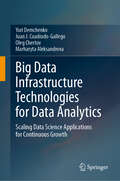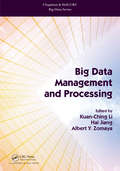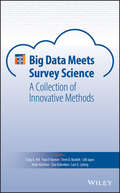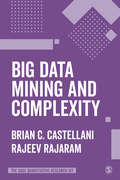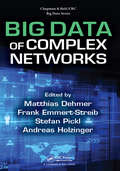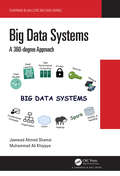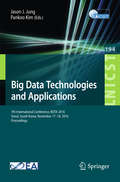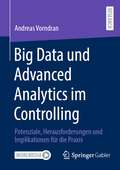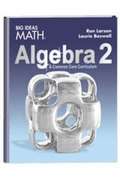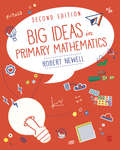- Table View
- List View
Big Data Baseball: Math, Miracles, and the End of a 20-Year Losing Streak
by Travis SawchikBig Data Baseball provides a behind-the-scenes look at how the Pittsburgh Pirates used big data strategies to end the longest losing streak in North American pro sports history.New York Times BestsellerAfter twenty consecutive losing seasons for the Pittsburgh Pirates, team morale was low, the club’s payroll ranked near the bottom of the sport, game attendance was down, and the city was becoming increasingly disenchanted with its team. Big Data Baseball is the story of how the 2013 Pirates, mired in the longest losing streak in North American pro sports history, adopted drastic big-data strategies to end the drought, make the playoffs, and turn around the franchise’s fortunes.Big Data Baseball is Moneyball for a new generation. Award-winning journalist Travis Sawchik takes you behind the scenes to expertly weave together the stories of the key figures who changed the way the Pirates played the game, revealing how a culture of collaboration and creativity flourished as whiz-kid analysts worked alongside graybeard coaches to revolutionize the sport and uncover groundbreaking insights for how to win more games without spending a dime.From pitch framing to on-field shifts, this entertaining and enlightening underdog story closely examines baseball’s burgeoning big data movement and demonstrates how the millions of data points which aren’t immediately visible to players and spectators, are the bit of magic that led the Pirates to finish the 2013 season in second place and brought an end to a twenty-year losing streak.
Big Data Finance in China (Contributions to Finance and Accounting)
by Mengyao Lin Wei Chen Wenting ZhangThis book starts by introducing the background of the era of data elements, clarifies the theoretical basis and technical methods related to big data, and analyzes the specific application of big data technology in China’s banking industry, the insurance industry, securities investment industry, third-party payment, risk supervision, and other fields. application, and thereby finally summarize useful experiences for big data development as well as effective regulation and supervision. We hope that this book can help with subsequent research and application of big data technology in the financial field. This book has a broad audience, especially scholars and practitioners. It is a valuable reference for researchers in related fields, and it can also provide some insights into financial regulators’ awareness of big data finance. Furthermore, it aids in formulating and improving consumption policies, adjusting economic structures, and preventing risks under financial innovation. This research provides valuable guidance for improving financial innovation as well as the effective regulation thereon by financial regulators.
Big Data for Remote Sensing: Digital Earth And Smart Earth
by Amira S. Ashour Chintan Bhatt Nilanjan DeyThis book thoroughly covers the remote sensing visualization and analysis techniques based on computational imaging and vision in Earth science. Remote sensing is considered a significant information source for monitoring and mapping natural and man-made land through the development of sensor resolutions that committed different Earth observation platforms. The book includes related topics for the different systems, models, and approaches used in the visualization of remote sensing images. It offers flexible and sophisticated solutions for removing uncertainty from the satellite data. It introduces real time big data analytics to derive intelligence systems in enterprise earth science applications. Furthermore, the book integrates statistical concepts with computer-based geographic information systems (GIS). It focuses on image processing techniques for observing data together with uncertainty information raised by spectral, spatial, and positional accuracy of GPS data. The book addresses several advanced improvement models to guide the engineers in developing different remote sensing visualization and analysis schemes. Highlights on the advanced improvement models of the supervised/unsupervised classification algorithms, support vector machines, artificial neural networks, fuzzy logic, decision-making algorithms, and Time Series Model and Forecasting are addressed. This book guides engineers, designers, and researchers to exploit the intrinsic design remote sensing systems. The book gathers remarkable material from an international experts' panel to guide the readers during the development of earth big data analytics and their challenges.
Big Data for Twenty-First-Century Economic Statistics (National Bureau of Economic Research Studies in Income and Wealth #79)
by Katharine G. Abraham, Ron S. Jarmin, Brian C. Moyer, and Matthew D. ShapiroThe papers in this volume analyze the deployment of Big Data to solve both existing and novel challenges in economic measurement. The existing infrastructure for the production of key economic statistics relies heavily on data collected through sample surveys and periodic censuses, together with administrative records generated in connection with tax administration. The increasing difficulty of obtaining survey and census responses threatens the viability of existing data collection approaches. The growing availability of new sources of Big Data—such as scanner data on purchases, credit card transaction records, payroll information, and prices of various goods scraped from the websites of online sellers—has changed the data landscape. These new sources of data hold the promise of allowing the statistical agencies to produce more accurate, more disaggregated, and more timely economic data to meet the needs of policymakers and other data users. This volume documents progress made toward that goal and the challenges to be overcome to realize the full potential of Big Data in the production of economic statistics. It describes the deployment of Big Data to solve both existing and novel challenges in economic measurement, and it will be of interest to statistical agency staff, academic researchers, and serious users of economic statistics.
Big Data for Twenty-First-Century Economic Statistics (National Bureau of Economic Research Studies in Income and Wealth #79)
by Katharine G. Abraham, Ron S. Jarmin, Brian C. Moyer, and Matthew D. ShapiroThe papers in this volume analyze the deployment of Big Data to solve both existing and novel challenges in economic measurement. The existing infrastructure for the production of key economic statistics relies heavily on data collected through sample surveys and periodic censuses, together with administrative records generated in connection with tax administration. The increasing difficulty of obtaining survey and census responses threatens the viability of existing data collection approaches. The growing availability of new sources of Big Data—such as scanner data on purchases, credit card transaction records, payroll information, and prices of various goods scraped from the websites of online sellers—has changed the data landscape. These new sources of data hold the promise of allowing the statistical agencies to produce more accurate, more disaggregated, and more timely economic data to meet the needs of policymakers and other data users. This volume documents progress made toward that goal and the challenges to be overcome to realize the full potential of Big Data in the production of economic statistics. It describes the deployment of Big Data to solve both existing and novel challenges in economic measurement, and it will be of interest to statistical agency staff, academic researchers, and serious users of economic statistics.
Big Data in Complex and Social Networks (Chapman & Hall/CRC Big Data Series)
by My T. Thai, Weili Wu, Hui XiongThis book presents recent developments on the theoretical, algorithmic, and application aspects of Big Data in Complex and Social Networks. The book consists of four parts, covering a wide range of topics. The first part of the book focuses on data storage and data processing. It explores how the efficient storage of data can fundamentally support intensive data access and queries, which enables sophisticated analysis. It also looks at how data processing and visualization help to communicate information clearly and efficiently. The second part of the book is devoted to the extraction of essential information and the prediction of web content. The book shows how Big Data analysis can be used to understand the interests, location, and search history of users and provide more accurate predictions of User Behavior. The latter two parts of the book cover the protection of privacy and security, and emergent applications of big data and social networks. It analyzes how to model rumor diffusion, identify misinformation from massive data, and design intervention strategies. Applications of big data and social networks in multilayer networks and multiparty systems are also covered in-depth.
Big Data in Education: The digital future of learning, policy and practice
by Ben WilliamsonBig data has the power to transform education and educational research. Governments, researchers and commercial companies are only beginning to understand the potential that big data offers in informing policy ideas, contributing to the development of new educational tools and innovative ways of conducting research. This cutting-edge overview explores the current state-of-play, looking at big data and the related topic of computer code to examine the implications for education and schooling for today and the near future. Key topics include: · The role of learning analytics and educational data science in schools · A critical appreciation of code, algorithms and infrastructures · The rise of ‘cognitive classrooms’, and the practical application of computational algorithms to learning environments · Important digital research methods issues for researchers This is essential reading for anyone studying or working in today's education environment!
Big Data in Education: The digital future of learning, policy and practice
by Ben WilliamsonBig data has the power to transform education and educational research. Governments, researchers and commercial companies are only beginning to understand the potential that big data offers in informing policy ideas, contributing to the development of new educational tools and innovative ways of conducting research. This cutting-edge overview explores the current state-of-play, looking at big data and the related topic of computer code to examine the implications for education and schooling for today and the near future. Key topics include: · The role of learning analytics and educational data science in schools · A critical appreciation of code, algorithms and infrastructures · The rise of ‘cognitive classrooms’, and the practical application of computational algorithms to learning environments · Important digital research methods issues for researchers This is essential reading for anyone studying or working in today's education environment!
Big Data in Finance: Volume 1 (Studies in Big Data #164)
by Bahaaeddin AlareeniThis book offers a comprehensive exploration of how Big Data analytics is reshaping the financial world, providing crucial insights for industry professionals, scholars, and enthusiasts alike. This book delves into the expansive potential of Big Data in revolutionizing financial decision-making, risk management, and operational efficiency. It explores how advanced analytics, machine learning, and artificial intelligence are disrupting traditional financial models, empowering institutions with unparalleled insights and a competitive edge. While highlighting technological advancements, the book also addresses the challenges and ethical considerations inherent in data-driven finance. With contributions from leading experts and thought leaders, this book serves as an indispensable resource for anyone eager to understand and harness the transformative power of Big Data in finance. Embark on a journey through the dynamic convergence of finance and technology, and discover how Big Data is shaping the future of the financial landscape, one data point at a time.
Big Data in Omics and Imaging: Association Analysis (Chapman & Hall/CRC Mathematical and Computational Biology)
by Momiao XiongBig Data in Omics and Imaging: Association Analysis addresses the recent development of association analysis and machine learning for both population and family genomic data in sequencing era. It is unique in that it presents both hypothesis testing and a data mining approach to holistically dissecting the genetic structure of complex traits and to designing efficient strategies for precision medicine. The general frameworks for association analysis and machine learning, developed in the text, can be applied to genomic, epigenomic and imaging data. FEATURES Bridges the gap between the traditional statistical methods and computational tools for small genetic and epigenetic data analysis and the modern advanced statistical methods for big data Provides tools for high dimensional data reduction Discusses searching algorithms for model and variable selection including randomization algorithms, Proximal methods and matrix subset selection Provides real-world examples and case studies Will have an accompanying website with R code The book is designed for graduate students and researchers in genomics, bioinformatics, and data science. It represents the paradigm shift of genetic studies of complex diseases– from shallow to deep genomic analysis, from low-dimensional to high dimensional, multivariate to functional data analysis with next-generation sequencing (NGS) data, and from homogeneous populations to heterogeneous population and pedigree data analysis. Topics covered are: advanced matrix theory, convex optimization algorithms, generalized low rank models, functional data analysis techniques, deep learning principle and machine learning methods for modern association, interaction, pathway and network analysis of rare and common variants, biomarker identification, disease risk and drug response prediction.
Big Data in Psychological Research
by Sang Eun Woo Louis Tay Robert W. ProctorTechnological advances have led to an abundance of widely available data on every aspect of life today. Psychologists today have more information than ever before on human cognition, emotion, attitudes, and behavior. Big Data in Psychological Research addresses the opportunities and challenges that these data present to psychological researchers. This edited collection provides an overview of theoretical approaches to the utility and purpose of big data, approaches to research design and analysis, collection methods, applications, limitations, best practice recommendations, and key issues related to privacy, security, and ethical concerns that are essential to understand for anyone working with big data. The book also discusses potential future research directions aimed at improving the quality and interpretation of big data projects, as well as the training and evaluation of psychological science teams that conduct research using big data.
Big Data Infrastructure Technologies for Data Analytics: Scaling Data Science Applications for Continuous Growth
by Yuri Demchenko Juan J. Cuadrado-Gallego Oleg Chertov Marharyta AleksandrovaThis book provides a comprehensive overview and introduction to Big Data Infrastructure technologies, existing cloud-based platforms, and tools for Big Data processing and data analytics, combining both a conceptual approach in architecture design and a practical approach in technology selection and project implementation. Readers will learn the core functionality of major Big Data Infrastructure components and how they integrate to form a coherent solution with business benefits. Specific attention will be given to understanding and using the major Big Data platform Apache Hadoop ecosystem, its main functional components MapReduce, HBase, Hive, Pig, Spark and streaming analytics. The book includes topics related to enterprise and research data management and governance and explains modern approaches to cloud and Big Data security and compliance. The book covers two knowledge areas defined in the EDISON Data Science Framework (EDSF): Data Science Engineering and Data Management and Governance and can be used as a textbook for university courses or provide a basis for practitioners for further self-study and practical use of Big Data technologies and competent evaluation and implementation of practical projects in their organizations.
Big Data Management and Processing (Chapman & Hall/CRC Big Data Series)
by Kuan-Ching Li, Hai Jiang and Albert Y. ZomayaFrom the Foreword: "Big Data Management and Processing is [a] state-of-the-art book that deals with a wide range of topical themes in the field of Big Data. The book, which probes many issues related to this exciting and rapidly growing field, covers processing, management, analytics, and applications... [It] is a very valuable addition to the literature. It will serve as a source of up-to-date research in this continuously developing area. The book also provides an opportunity for researchers to explore the use of advanced computing technologies and their impact on enhancing our capabilities to conduct more sophisticated studies." ---Sartaj Sahni, University of Florida, USA "Big Data Management and Processing covers the latest Big Data research results in processing, analytics, management and applications. Both fundamental insights and representative applications are provided. This book is a timely and valuable resource for students, researchers and seasoned practitioners in Big Data fields. --Hai Jin, Huazhong University of Science and Technology, China Big Data Management and Processing explores a range of big data related issues and their impact on the design of new computing systems. The twenty-one chapters were carefully selected and feature contributions from several outstanding researchers. The book endeavors to strike a balance between theoretical and practical coverage of innovative problem solving techniques for a range of platforms. It serves as a repository of paradigms, technologies, and applications that target different facets of big data computing systems. The first part of the book explores energy and resource management issues, as well as legal compliance and quality management for Big Data. It covers In-Memory computing and In-Memory data grids, as well as co-scheduling for high performance computing applications. The second part of the book includes comprehensive coverage of Hadoop and Spark, along with security, privacy, and trust challenges and solutions. The latter part of the book covers mining and clustering in Big Data, and includes applications in genomics, hospital big data processing, and vehicular cloud computing. The book also analyzes funding for Big Data projects.
Big Data Meets Survey Science: A Collection of Innovative Methods (Wiley Series in Survey Methodology)
by Craig A HillOffers a clear view of the utility and place for survey data within the broader Big Data ecosystem This book presents a collection of snapshots from two sides of the Big Data perspective. It assembles an array of tangible tools, methods, and approaches that illustrate how Big Data sources and methods are being used in the survey and social sciences to improve official statistics and estimates for human populations. It also provides examples of how survey data are being used to evaluate and improve the quality of insights derived from Big Data. Big Data Meets Survey Science: A Collection of Innovative Methods shows how survey data and Big Data are used together for the benefit of one or more sources of data, with numerous chapters providing consistent illustrations and examples of survey data enriching the evaluation of Big Data sources. Examples of how machine learning, data mining, and other data science techniques are inserted into virtually every stage of the survey lifecycle are presented. Topics covered include: Total Error Frameworks for Found Data; Performance and Sensitivities of Home Detection on Mobile Phone Data; Assessing Community Wellbeing Using Google Street View and Satellite Imagery; Using Surveys to Build and Assess RBS Religious Flag; and more. Presents groundbreaking survey methods being utilized today in the field of Big Data Explores how machine learning methods can be applied to the design, collection, and analysis of social science data Filled with examples and illustrations that show how survey data benefits Big Data evaluation Covers methods and applications used in combining Big Data with survey statistics Examines regulations as well as ethical and privacy issues Big Data Meets Survey Science: A Collection of Innovative Methods is an excellent book for both the survey and social science communities as they learn to capitalize on this new revolution. It will also appeal to the broader data and computer science communities looking for new areas of application for emerging methods and data sources.
Big Data Mining and Complexity (The SAGE Quantitative Research Kit)
by Brian C. Castellani Rajeev RajaramThis book offers a much needed critical introduction to data mining and ‘big data’. Supported by multiple case studies and examples, the authors provide: Digestible overviews of key terms and concepts relevant to using social media data in quantitative research. A critical review of data mining and ‘big data’ from a complexity science perspective, including its future potential and limitations A practical exploration of the challenges of putting together and managing a ‘big data’ database An evaluation of the core mathematical and conceptual frameworks, grounded in a case-based computational modeling perspective, which form the foundations of all data mining techniques Part of The SAGE Quantitative Research Kit, this book will give you the know-how and confidence needed to succeed on your quantitative research journey.
Big Data Mining and Complexity (The SAGE Quantitative Research Kit)
by Brian C. Castellani Rajeev RajaramThis book offers a much needed critical introduction to data mining and ‘big data’. Supported by multiple case studies and examples, the authors provide: Digestible overviews of key terms and concepts relevant to using social media data in quantitative research. A critical review of data mining and ‘big data’ from a complexity science perspective, including its future potential and limitations A practical exploration of the challenges of putting together and managing a ‘big data’ database An evaluation of the core mathematical and conceptual frameworks, grounded in a case-based computational modeling perspective, which form the foundations of all data mining techniques Part of The SAGE Quantitative Research Kit, this book will give you the know-how and confidence needed to succeed on your quantitative research journey.
Big Data of Complex Networks (Chapman & Hall/CRC Big Data Series)
by Matthias Dehmer, Frank Emmert-Streib, Stefan Pickl and Andreas HolzingerBig Data of Complex Networks presents and explains the methods from the study of big data that can be used in analysing massive structural data sets, including both very large networks and sets of graphs. As well as applying statistical analysis techniques like sampling and bootstrapping in an interdisciplinary manner to produce novel techniques for analyzing massive amounts of data, this book also explores the possibilities offered by the special aspects such as computer memory in investigating large sets of complex networks. Intended for computer scientists, statisticians and mathematicians interested in the big data and networks, Big Data of Complex Networks is also a valuable tool for researchers in the fields of visualization, data analysis, computer vision and bioinformatics. Key features: Provides a complete discussion of both the hardware and software used to organize big data Describes a wide range of useful applications for managing big data and resultant data sets Maintains a firm focus on massive data and large networks Unveils innovative techniques to help readers handle big data Matthias Dehmer received his PhD in computer science from the Darmstadt University of Technology, Germany. Currently, he is Professor at UMIT – The Health and Life Sciences University, Austria, and the Universität der Bundeswehr München. His research interests are in graph theory, data science, complex networks, complexity, statistics and information theory. Frank Emmert-Streib received his PhD in theoretical physics from the University of Bremen, and is currently Associate professor at Tampere University of Technology, Finland. His research interests are in the field of computational biology, machine learning and network medicine. Stefan Pickl holds a PhD in mathematics from the Darmstadt University of Technology, and is currently a Professor at Bundeswehr Universität München. His research interests are in operations research, systems biology, graph theory and discrete optimization. Andreas Holzinger received his PhD in cognitive science from Graz University and his habilitation (second PhD) in computer science from Graz University of Technology. He is head of the Holzinger Group HCI-KDD at the Medical University Graz and Visiting Professor for Machine Learning in Health Informatics Vienna University of Technology.
Big Data Systems: A 360-degree Approach
by Jawwad Ahmad ShamsiBig Data Systems encompass massive challenges related to data diversity, storage mechanisms, and requirements of massive computational power. Further, capabilities of big data systems also vary with respect to type of problems. For instance, distributed memory systems are not recommended for iterative algorithms. Similarly, variations in big data systems also exist related to consistency and fault tolerance. The purpose of this book is to provide a detailed explanation of big data systems. The book covers various topics including Networking, Security, Privacy, Storage, Computation, Cloud Computing, NoSQL and NewSQL systems, High Performance Computing, and Deep Learning. An illustrative and practical approach has been adopted in which theoretical topics have been aided by well-explained programming and illustrative examples. Key Features: Introduces concepts and evolution of Big Data technology. Illustrates examples for thorough understanding. Contains programming examples for hands on development. Explains a variety of topics including NoSQL Systems, NewSQL systems, Security, Privacy, Networking, Cloud, High Performance Computing, and Deep Learning. Exemplifies widely used big data technologies such as Hadoop and Spark. Includes discussion on case studies and open issues. Provides end of chapter questions for enhanced learning.
Big Data Technologies and Applications: 7th International Conference, BDTA 2016, Seoul, South Korea, November 17–18, 2016, Proceedings (Lecture Notes of the Institute for Computer Sciences, Social Informatics and Telecommunications Engineering #194)
by Jason J. Jung Pankoo KimThis book constitutes the refereed post-conference proceedings of the 7th International Conference on Big data Technologies and Applications, BDTA 2016, held in Seoul, South Korea, in November 2016. BDTA 2016 was collocated with the First International Workshop on Internet of Things, Social Network, and Security in Big Data, ISSB 2016 and the First International Workshop on Digital Humanity with Big Data, DiHuBiDa 2016. The 17 revised full papers were carefully reviewed and selected from 25 submissions and handle theoretical foundations and practical applications which premise the new generation of data analytics and engineering.
Big Data und Advanced Analytics im Controlling: Potenziale, Herausforderungen und Implikationen für die Praxis
by Andreas VorndranDie Digitalisierung und Entwicklungen im Gebiet der künstlichen Intelligenz haben in den letzten Jahren erhebliche Veränderungen in der Gesellschaft und der Unternehmenspraxis hervorgerufen. Aufkommende Technologien in den Feldern Big Data und Advanced Analytics werden auch im Controlling zunehmend diskutiert oder bereits eingesetzt. Dabei befinden sich der Wissensstand, inwieweit Big Data und Advanced Analytics das Controlling beeinflussen und verändern können, und die praktische Anwendung noch in einem frühen Stadium. Diese Arbeit befasst sich deshalb mit der Untersuchung der möglichen Auswirkungen von Big Data und Advanced Analytics im Controlling. Vor diesem Hintergrund werden die Einflüsse dieser digitalen Trends auf den Informationsversorgungsprozess des Controllings, auf die Erfüllung Controlling-spezifischer Anforderungen an Informationen und auf das Forecasting, die Budgetierung und die strategische Planung analysiert. Ferner werden praxisrelevante Herausforderungen, Grenzen und Risiken bei der Implementierung und Nutzung identifiziert sowie Implikationen zu deren Umgang zur Ausschöpfung der Potenziale abgeleitet.
Big Ideas Algebra 2 (Big Ideas Math Algebra 2 Ser.)
by Houghton Mifflin Harcourt Publishing Company Staff Ron LarsonConsistent with the philosophy of the Common Core State Standards and Standards for Mathematical Practice, the Big Ideas Math Student Edition provides students with diverse opportunities to develop problem-solving and communication skills through deductive reasoning and exploration. Students gain a deeper understanding of math concepts by narrowing their focus to fewer topics at each grade level. Students master content through inductive reasoning opportunities, engaging activites that provide deeper understanding, concise, stepped-out examples, rich, thought-provoking exercises, and a continual building on what has previously been taught.
Big Ideas for Growing Mathematicians: Exploring Elementary Math with 20 Ready-to-Go Activities
by Ann KajanderIntroducing sophisticated mathematical ideas like fractals and infinity, these hands-on activity books present concepts to children using interactive and comprehensible methods. With intriguing projects that cover a wide range of math content and skills, these are ideal resources for elementary school mathematics enrichment programs, regular classroom instruction, and home-school programs. Reproducible activity sheets lead students through a process of engaged inquiry with plenty of helpful tips along the way. A list of useful terms specific to each activity encourages teachers and parents to introduce students to the vocabulary of math. This second Big Ideas book covers more advanced concepts, with projects including "One in a Million," where children use grains of rice to model the probability of astronomical odds; "Triangular Tessellations," in which students investigate the geometry and variations created by repeating patterns; and "Fractions of Salaries," where kids use a real-world scenario to multiply and divide fractions.
Big Ideas for Small Mathematicians: Kids Discovering the Beauty of Math with 22 Ready-to-Go Activities
by Ann KajanderIntroducing sophisticated mathematical ideas like fractals and infinity, these hands-on activity books present concepts to children using interactive and comprehensible methods. With intriguing projects that cover a wide range of math content and skills, these are ideal resources for elementary school mathematics enrichment programs, regular classroom instruction, and home-school programs. Reproducible activity sheets lead students through a process of engaged inquiry with plenty of helpful tips along the way. A list of useful terms specific to each activity encourages teachers and parents to introduce students to the vocabulary of math. Projects in this first of the two Big Ideas books include "Straw Structures," where children get hands-on experience with measurement and 3-D visualization; "Kaleidoscopes," in which students use geometry to build a mathematical toy; and "Crawling Around the Möbius Strip," where kids build a physical example of infinity.
Big Ideas in Primary Mathematics
by Robert NewellThis book explains ‘big ideas’ in mathematics in simple terms supported by classroom examples to show how they can be applied in primary schools to enable learning. Carefully linked to the National Curriculum, it covers all the major concepts so you can develop your own mathematical subject knowledge and to give you the confidence to deepen your understanding of the children you teach. This second edition includes: · A new ‘links with mastery’ feature showing how to teach with mastery in mind · A new glossary of key terms · New big ideas and activities throughout
Big Ideas in Primary Mathematics
by Robert NewellThis book explains ‘big ideas’ in mathematics in simple terms supported by classroom examples to show how they can be applied in primary schools to enable learning. Carefully linked to the National Curriculum, it covers all the major concepts so you can develop your own mathematical subject knowledge and to give you the confidence to deepen your understanding of the children you teach. This second edition includes: · A new ‘links with mastery’ feature showing how to teach with mastery in mind · A new glossary of key terms · New big ideas and activities throughout
